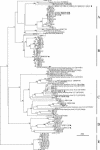Chitinase gene sequences retrieved from diverse aquatic habitats reveal environment-specific distributions
- PMID: 15574890
- PMCID: PMC535185
- DOI: 10.1128/AEM.70.12.6977-6983.2004
Chitinase gene sequences retrieved from diverse aquatic habitats reveal environment-specific distributions
Abstract
Chitin is an abundant biopolymer whose degradation is mediated primarily by bacterial chitinases. We developed a degenerate PCR primer set to amplify a approximately 900-bp fragment of family 18, group I chitinase genes and used it to retrieve these gene fragments from environmental samples. Clone libraries of presumptive chitinase genes were created for nine water and six sediment samples from 10 aquatic environments including freshwater and saline lakes, estuarine water and sediments, and the central Arctic Ocean. Putative chitinase sequences were also retrieved from the Sargasso Sea metagenome sequence database. We were unable to obtain PCR product with these primers from an alkaline, hypersaline lake (Mono Lake, California). In total, 108 partial chitinase gene sequences were analyzed, with a minimum of 5 and a maximum of 13 chitinase sequences obtained from each library. All chitinase sequences were novel compared to previously identified sequences. Intralibrary sequence diversity was low, while we found significant differences between libraries from different water column samples and between water column and sediment samples. However, identical sequences were retrieved from samples collected at widely distributed locations that did not necessarily represent similar environments, suggesting homogeneity of chitinoclastic communities between some environments.
Figures



References
-
- Bassler, B. L., C. Yu, Y. C. Lee, and S. Roseman. 1991. Chitin utilization by marine bacteria. Degradation and catabolism of chitin oligosaccharides by Vibrio furnissii. J. Biol. Chem. 266:24276-24286. - PubMed
-
- Beutel, M. W., A. J. Horne, J. C. Roth, and N. J. Barratt. 2001. Limnological effects of anthropogenic desiccation of a large, saline lake, Walker Lake, Nevada. Hydrobiologia 466:91-105.
-
- Chalmers, A. G. 1997. The ecology of the Sapelo Island National Estuarine Research Reserve. Office of Coastal Resource Management, National Oceanic and Atmospheric Administration, Washington, D.C.
Publication types
MeSH terms
Substances
Associated data
- Actions
- Actions
- Actions
- Actions
- Actions
- Actions
- Actions
- Actions
- Actions
- Actions
- Actions
- Actions
- Actions
- Actions
- Actions
- Actions
- Actions
- Actions
- Actions
- Actions
- Actions
- Actions
- Actions
- Actions
- Actions
- Actions
- Actions
- Actions
- Actions
- Actions
- Actions
- Actions
- Actions
- Actions
- Actions
- Actions
- Actions
- Actions
- Actions
- Actions
- Actions
- Actions
- Actions
- Actions
- Actions
- Actions
- Actions
- Actions
- Actions
- Actions
- Actions
- Actions
- Actions
- Actions
- Actions
- Actions
- Actions
- Actions
- Actions
- Actions
- Actions
- Actions
- Actions
- Actions
- Actions
- Actions
- Actions
- Actions
- Actions
- Actions
- Actions
- Actions
- Actions
- Actions
- Actions
- Actions
- Actions
- Actions
- Actions
- Actions
- Actions
- Actions
- Actions
- Actions
- Actions
- Actions
- Actions
- Actions
- Actions
- Actions
- Actions
- Actions
- Actions
- Actions
- Actions
- Actions
- Actions
- Actions
- Actions
- Actions
- Actions
- Actions
- Actions
- Actions
- Actions
- Actions
- Actions
- Actions
LinkOut - more resources
Full Text Sources

